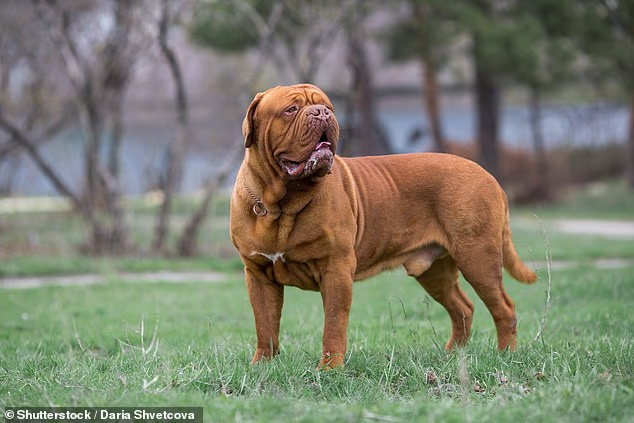A new study has revealed the dog breeds at the highest risk of aggressive canine cancer – with large dogs at the top of the list.
Also known as haemangiosarcoma, canine cancer is a fast–growing cancer in dogs, which often proves fatal.
Until now, the risk factors for the disease – especially in relation to breeds – have remained uncelar.
To get to the bottom of it, vets from the Royal Veterinary College analysed the records of more than one million dogs.
Their analysis revealed that the risk of haemangiosarcoma is ‘strongly influenced’ by breed.
Dogue de Bordeaux was found to be the breed with the highest odds of developing cancer, followed by Flat Coated Retriever, German Shepherd and Hungarian Vizsla.
‘Haemangiosarcoma can be a challenging cancer to confidently diagnose in first opinion practice when timing is of the essence,’ said Dr Georgie Barry, lead author of the paper.
‘Dogs often present very unwell and it can be an incredibly emotional and distressing time for owners to make big decisions over their dog’s care. We hope these findings will support first opinion vets in guiding diagnoses to support owners and provide the most appropriate care for their canine patients in a timely manner.’
A new study has revealed the dog breeds at the highest risk of aggressive canine cancer – with large dogs at the top of the list. Pictured: Dogue de Bordeaux

Vets from the Royal Veterinary College analysed the records of more than one million dogs. Their analysis revealed that the risk of haemangiosarcoma is ‘strongly influenced’ by breed
Haemangiosarcoma is a rapidly developing cancer of the blood vessels.
Sadly, the disease has extremely poor survival rates, with many owners faced with the heartbreaking decision to consider euthanasia.
Previous research has found that the condition usually affects older dogs.
However, until now, the breeds most affected have been unknown.
In their new study, the team analysed the health records of dogs aged at least five years, which were under primary veterinary care during 2019.
The records documented their breed, age, bodyweight, sex/neuter status, socioeconomic status, location, and whether or not they had been diagnosed with haemangiosarcoma.
The results revealed that both age and bodyweight are important risk factors for the cancer.
Dogs aged between 11 and 13 were more than twice as likely to be diagnosed with the disease, while pups weighing more than 37.4kg were more than four times at risk than those weighing between 7.5kg and 15kg.

At a breed level, Dogue de Bordeaux were 9.5 times more likely to develop the cancer, ahead of Flat Coated Retrievers (pictured, 8.3x), German Shepherds (6.3x) and Hungarian Vizslas (5.5x)

Yorkshire Terriers (pictured) were the least likely to be diagnosed with the disease, followed by Chihuahuas, Lhasa Apsos and Border Terriers
At a breed level, Dogue de Bordeaux were 9.5 times more likely to develop the cancer, ahead of Flat Coated Retreivers (8.3x), German Shepherds (6.3x) and Hungarian Vizslas (5.5x).
In contrast, Yorkshire Terriers were the least likely to be diagnosed with the disease, followed by Chihuahuas, Lhasa Apsos and Border Terriers.
Location and socioeconomic status were also found to affect the risk of cancer.
Dogs in the least deprived areas of the UK had 1.7 times the odds of being diagnosed with haemangiosarcoma, compared to those in the most deprived areas.
Menawhile, dogs in mixed urban/rural areas had slightly lower odds of being diagnosed that those living in cities.
Dr Sandra Guillen, an author of the paper, said: ‘This study highlights important patterns in the diagnosis of haemangiosarcoma in dogs across the UK and the findings not only shed light on the epidemiology of this aggressive cancer but also raise important questions about how demographic, geographic, and socioeconomic factors shape canine health outcomes.’
By
Source link



Leave a Reply